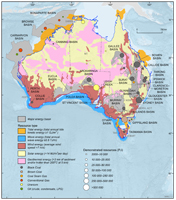News
Release of updated Australian Energy Resource Assessment
Published:27 June 2014
Release of updated Australian Energy Resource Assessment
Geoscience Australia and Bureau of Resources and Energy Economics have released an update of the Australian Energy Resource Assessment.
Australia's energy resources are a key contributor to Australia's economic prosperity. The updated assessment provides a snapshot of the nation's current energy resources - from fossil fuels and uranium to renewables; and identifies the key factors likely to influence their future use.
This update follows the first national assessment of Australia's energy resources released in 2010. Key points from the update include:
- Australia's estimated total demonstrated non-renewable energy resources, with the exception of oil, have increased since 2010.
- Our diverse energy resource base includes substantial coal resources that support domestic consumption and sizeable energy exports around the world.
- Australia has substantial uranium resources that support world-leading exports.
- Gas resources rank as Australia's third largest energy resource, supporting domestic consumption and a growing export market.
- Australia has limited crude oil resources and is increasingly reliant on imports for its transport fuels.
- Our nation is endowed with renewable wind, solar, geothermal, ocean and bioenergy sources. Wind and solar energy resources are being increasingly exploited, while geothermal and ocean energy remain largely undeveloped.
Overall, it is expected that domestic and international demand for Australia's energy resources will continue to rise over the next few decades; however the rate of this growth is expected to slow, and the types of energy used are likely to change as new technologies become more competitive.
The assessment is available for download from our website.
Contact:
Phone:
Email:





